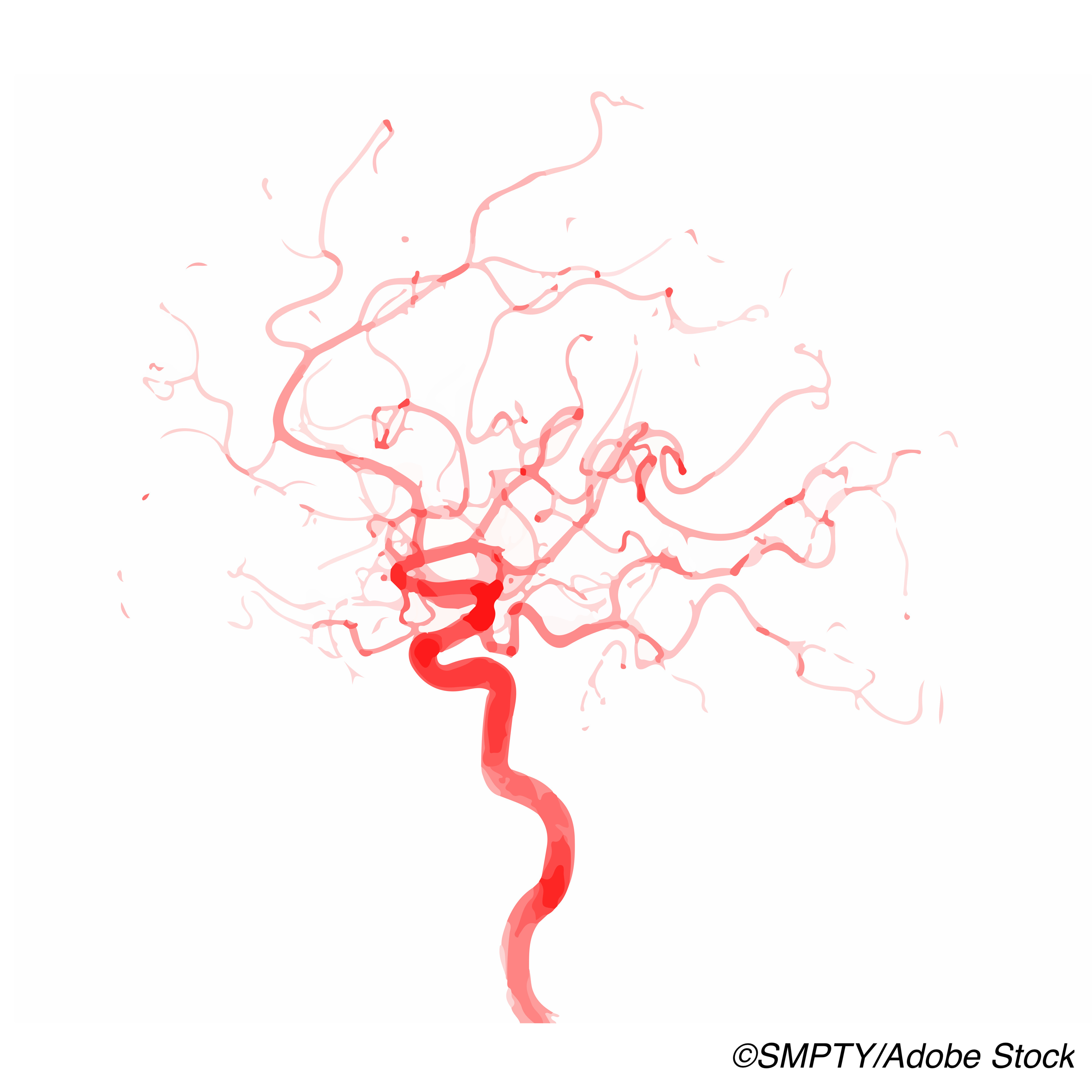Tenecteplase (TNKase) was associated with better reperfusion rates than alteplase (Activase) prior to endovascular thrombectomy of basilar artery occlusion (BAO), a small retrospective study of pooled trial and registry data suggested.
“This study provides Class III evidence that tenecteplase leads to higher reperfusion rates in comparison with alteplase prior to endovascular thrombectomy in BAO patients,” wrote Fana Alemseged, MD, of the University of Melbourne in Australia, and co-authors in Neurology. “Given BAO dismal prognosis, randomized controlled trials to compare tenecteplase with alteplase in BAO patients are warranted.”
Researchers analyzed patient level data for consecutive patients with BAO seen within 4.5 hours who were eligible for endovascular thrombectomy and intravenous thrombolysis (IVT). Patients were identified and pooled from the EXTEND-IA TNK (tenecteplase 0.25 mg/kg versus alteplase 0.9 mg/kg), EXTEND-IA TNK part 2 (tenecteplase 0.25 mg/kg versus tenecteplase 0.4 mg/kg) trials and the Basilar Artery Treatment and Management (BATMAN) registry.
Reperfusion occurred more frequently in patients treated with tenecteplase than alteplase (26% versus 7%; RR 4.0, 95% CI 1.3-12.0; P=0.02). No difference in symptomatic intracerebral hemorrhage was observed, with 0 of 19 cases for tenecteplase and 1 of 91 cases for alteplase.
“The study contributes to the field by exploring a promising alternative IV thrombolytic agent, tenecteplase, in the treatment of basilar artery occlusion prior to endovascular thrombectomy, wrote Michelle Lin, MD, MPH, of Mayo Clinic in Jacksonville, Florida, and Kameshwar Prasad, MD, DM, MMSc, of the All India Institute of Medical Sciences in New Delhi, in an accompanying editorial. “The efficacy of endovascular thrombectomy for BAO is similarly a topic with clinical equipoise. “
Mechanical endovascular thrombectomy is considered the standard of care for large vessel occlusion, but the role of giving IV alteplase in that setting is unclear. Since alteplase has a short half-life — it is infused over 1 hour to maintain activity — the idea that a longer half-life thrombolytic such as tenecteplase might have equal or better efficacy in the setting of large vessel occlusive stroke is attractive. Tenecteplase is given as a single bolus and approved for acute myocardial infarction. Tenecteplase is genetically modified tissue-plasminogen-activator with a six-times longer half-life and greater fibrin specificity and resistance to inhibitors.
A 2018 meta-analysis considered evidence from trials comparing tenecteplase with alteplase in patients with acute anterior circulation ischemic stroke and showed improvements in complete reperfusion (OR 2.01), early clinical improvement (OR 1.43) favoring tenecteplase, but no worsening of hemorrhage or mortality. Its authors concluded, “In network meta-analysis, there were better efficacy and imaging-based outcomes with tenecteplase 0.25 mg/kg without increased risk of safety outcomes. Our results demonstrate that in acute ischemic stroke, thrombolysis with tenecteplase is at least as effective and safe as alteplase.”
Alemseged and colleagues pooled data from EXTEND-IA TNK, EXTEND-IA TNK part 2, and the BATMAN registry. BATMAN (Oct. 2009-July 2019) is a multicenter registry of prospectively collected consecutive BAO patients. Patients within 4.5 hours after onset, eligible for intravenous thrombolysis (IVT) and EVT, were considered for this study. The EXTEND-IA TNK trial, between March 2015 and July 2019, was a prospective, randomized, open-label trial in ischemic stroke patients within 4.5 hours after onset who had internal carotid, middle cerebral, or basilar artery occlusion. Patients were eligible for IVT and EVT.
The pooled analysis included 110 BAO patients treated with intravenous thrombolysis prior to EVT. Mean age was 69, and 64% were male. Median NIHSS score was 16. Prior to EVT, tenecteplase (0.25 mg/kg or 0.4 mg/kg) was used in 19 patients and alteplase (0.9 mg/kg) in 91.
Those treated with tenecteplase were older (mean age 77 versus 67; P=0.01) and had shorter median time from IV thrombolysis-to-groin-puncture for EVT (48 minutes vs 110 minutes; P=0.004).
Reperfusion identified on initial conventional cerebral angiogram or noninvasive multimodal imaging prior to EVT was seen in 26 of the tenecteplase-treated patients versus 7% for alteplase (RR 4.0, 95% CI 1.3-12; P=0.02).
“Functional outcomes were similar between treatment groups, although our study was underpowered to detect such differences,” Alemseged and colleagues wrote. “Larger studies are needed to detect treatment effect differences between thrombolytic agents prior to EVT, given the potentially EVT large effect. However, the strong relationship between earlier reperfusion and functional improvement suggests tenecteplase could improve outcomes and be beneficial during transfer to endovascular centers.”
“At present, professional society guidelines lack consensus on when or if to use tenecteplase in place of alteplase,” Lin and Prasad noted. “Nevertheless, while the evidence base is the same, the variability in guideline recommendations suggests that the values and preferences differ among the guideline developers on the certainty of evidence and tradeoff between benefits and harms.”
“Some practitioners and patients may feel persuaded to use tenecteplase in place of alteplase, while others may justifiably wait for more evidence before they are convinced to do so, and may use tenecteplase in selected cases,” the editorialists added. “As of now, the use of tenecteplase is nearing a tipping point but is perhaps not ready for prime time.”
Limitations include the study’s lack of power to differentiate functional outcomes, along with those inherent to retrospective design. In addition, the number of patients receiving tenecteplase was small.
-
Tenecteplase was associated with better reperfusion rates than alteplase prior to endovascular thrombectomy of basilar artery occlusion (BAO) in a small retrospective analysis.
-
Given BAO’s dismal prognosis, randomized controlled trials comparing tenecteplase with alteplase in BAO patients are warranted, the researchers said.
Paul Smyth, MD, Contributing Writer, BreakingMED™
The authors reported no targeted funding.
Alemseged reported no disclosures relevant to the manuscript.
The editorialists reported no disclosures.
Cat ID: 8
Topic ID: 74,8,730,8,130,38,192,925



